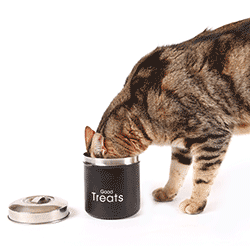Settling in and basic training
You and your cat will get to know each other with time, but starting with the right basic techniques will be a big help

Getting the rules sorted out from the start is important if you and your cat are going to get along. If you are starting with a new kitten, then all the rules are brand new, but if you have an adult cat you may need to spend some time shaping the cats habits. You can't really 'train' a cat, they are independant animals and will do as they please, but you can do a number of things to encourage desired behaviours and discourage unwanted behaviour.
Punishment for bad behaviour
Cats do not respond to punishment, and using force or shouting will only make your cat scared of you and even more problematic. If you try and stop bad behaviour by shouting directly at the cat or by hitting, all the cat will remember is being shouted at or attacked, but not why. A cat which is happy and confident around reassuring owners will generally be much better behaved and easier to adapt to new rules, so making your cat uncomfortable around you because of punishment will only create new problems.
Interruption
Instead of punishment, you can use 'interruption' to curb undesirable behaviour. A loud noise, such as a clap, which will momentarily get your cats attention and stop him in his tracks tends to work quite well. Another well known method is to use brief squirts of water from a water pistol. The key to both these methods is that the cat should not know that the water squirt or loud noise came from you (which why a clap rather than a shout is used) From the cats perspective, when it carries out the undesired action, something unpleasant but not harmful happens and the event is not connected to you. In the future, your cat will be less likely to carry out the behaviour and most importantly, because the unpleasant event is not connected with you, the cats activities will be altered even when you are not there.

Treats are a way to reward good behaviour - but not too many!
Rewards
Equally as good as interruptions are rewards to reinforce desirable behaviours such as using a litter tray or scratching post, coming in when called, or even things like play times or for sitting patiently at a distance whilst owners are eating. Rewarding your cat can be done with affection or with treats, but treats should not be overdone or you risk the cat acting to get food, or getting overfed.
Litter trays
The in's and out's of litter training are described in detail in another article, but a few basics are worth knowing right away. In most cases a cat or kitten will already be used to using a litter tray and providing you have a litter tray which is similar and uses the same litter, there will normally be few problems. Sometimes your new cat or kitten will not use the litter tray at first, this may be just because it has not got used to where everything is. Make sure the tray is accessible, in a safe and private location, and away from eating areas.
If your cat goes to the toilet on the floor, a common response by an owner is to show the cat its waste and punish the cat, this does not work and will simply make the cat less trusting. Instead, try placing your cat in the litter tray after feeding, if he goes to the toilet, give him lots of praise.
Scratching
Scratching is essential for a cat to keep its claws short and in good health, it is also another way for your cat to mark its scent on objects. Cats need to scratch and you must give them some way of doing so. Scratching posts and mats will be used quite quickly, but your cat may not know that sofas, chairs, carpets and curtains are not the same as scratching posts. If you spot your cat scratching something he shouldn't, clap your hands loudly and he will momentarily stop, when and if he resumes, clap again. Your cat will soon learn not to scratch things. Be careful not to clap too soon, sometimes it looks as if a cat is about to scratch carpet when in fact he is just stretching. If you are teaching your cat about scratching it can help to give lots of praise after your cat has used his scratching post or mat.
Settling time
It will normally take a week for an initial settling in period, after this time your new cat will be used to the basic house layout, feeding times, and the habits of its owners. Over the next few weeks your cat will discover new places and develop new routines until he is fully comfortable. Even if your cat is normally used to going outside, it should be kept indoors for at least the first week and the first few excursions should be supervised.

















